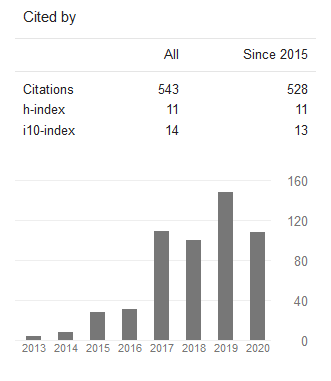Monitoring Log Aplikasi Mobile Native Menggunakan Framework Grr Rapid Response
DOI:
https://doi.org/10.24002/jbi.v10i1.1909Abstract
Abstract.
In order to acquire the data in the security investigation process comprehensively,
respondents need to take general information that uses logs, configured services, cron tasks, patch statuses, and user accounts. This information are known as forensic artifacts. The location and format are varied by system. One manifestation of forensic artifacts that is frequently investigated is files. A Quick Response Grr Framework has been created to describe forensic artifacts that allow data collected and conditioned to quickly use forensics directly on the original mobile application log using Laravel. Retrieving forensic evidence uses the NIST method which has steps such as acquisition, examination, analysis and report. This research produces log files from the laravel framework and detailed activity information from users when accessing the server. The results for which the log is obtained will become evident to be the material of the report.
Keywords: Grr, Forensic, Framework, Laravel
Abstrak.
Agar akuisisi data pada proses investigasi keamanan dapat dilakukan secara komprehensif, responden perlu mengambil informasi umum yang mencakup log, layanan terkonfigurasi, tugas cron, status patch, dan akun pengguna. Informasi-informasi ini dikenal sebagai artefak forensik. Lokasi dan formatnya bervariasi di setiap sistem. Salah satu manifestasi dari artefak forensik yang sering diinvestigasi oleh para praktisi adalah file. Framework Grr Rapid Response telah membangun kerangka kerja untuk mendeskripsikan artefak forensik yang memungkinkan data yang diperlukan dapat dikumpulkan dan dikondisikan dengan cepat menggunakan live forensics pada log aplikasi mobile native menggunakan laravel. Pengambilan barang bukti forensik menggunakan metode NIST memiliki langkah-langkah seperti akuisisi, eksaminasi, analisis, dan pelaporan. Penelitian ini menghasilkan log file dari framework laravel dan informasi aktifitas detail dari user saat mengakses server. Hasil log yang diperoleh akan menjadi barang bukti untuk untuk menjadi bahan laporan.
Kata Kunci: Grr, Forensik, Framework, Laravel
References
R. F. Cassidy, A. Chavez, J. Trent, and J. Urrea, “Remote Forensic Analysis of Process Control Systems,” IFIP International Federation for Information Processing Critical Infrastructure Protection, pp. 223–235, 2008. [2] Rosmiati, and I. Riadi, “Analisis Keamanan Informasi Berdasarkan Kebutuhan Teknikal Dan Operasional Mengkombinasikan Standar Iso 27001:2005 Dengan Maturity Level (Studi Kasus Kantor Biro Teknologi Informasi PT. XYZ),” Semin. Nas. Teknol. Inf. Dan Multimed, vol. 6, no. 6, pp. 6–7, 2016.
A. Yudhana, W. Yunanri, I. and Riadi, “Analisis Keamanan Webserver Menggunakan Metode Penetrasi Testing,” Annual Research Seminar (ARS), vol. 2, no. 1, pp. 300–304, 2016.
M. N. Faiz, R. Umar, and A. Yudhana, “Implementasi Live Forensics untuk Perbandingan Browser pada Keamanan Email,” JISKA (jurnal informatika sunan kalijaga), vol. 1, no. 3, pp. 108–114, 2017.
M. S. Ahmad, I. Riadi, and Y. Prayudi, “Investigasi Live Forensik Dari Sisi Pengguna Untuk Menganalisa Serangan Man in the Middle Attack Berbasis Evil Twin,” ILKOM Jurnal Ilmiah, vol. 9, no. 1, pp. 1–8, 2017.
I. Riadi, R. Umar, and I. Nasrulloh, “Experimental Investigation of Frozen Solid State Drive on Digital Evidence with Static Forensic Methods,” Lontar, vol. 9, no. 3, pp. 169–181, 2018.
I. Riadi, R. Umar, and I. M. Nasrulloh, “Analisis Forensik Digital Pada Frozen Solid State Drive Dengan Metode National Institute of Justice (NIJ),” Elinvo (Electronics, Informatics, and Vocational Education), vol. 3, no. 1, pp. 70–82, 2018. [8] F. Cruz, A. Moser, and M. Cohen, “A scalable file based data store for forensic analysis,” Digital Investigation, vol. 12, pp. S90–S101, 2015.
A. Yudhana, I. Riadi, and I. Anshori, “Analisis Bukti Digital Facebook Messenger Menggunakan Metode Nist,” IT JOURNAL RESEARCH AND DEVELOPMENT, vol. 3, no. 1, pp. 13–21, 2018. [10] A. A. Mohallel, J. M. Bass, and A. Dehghantaha, “Experimenting with docker: Linux container and base OS attack surfaces,” 2016 International Conference on Information Society (i-Society), pp. 17-21, 2016.
F. Sahrul, M. A. Safi’ie, and W. A. O. Decroly, “Implementasi Sistem Informasi Akademik Berbasis Web Menggunakan Framework Laravel”, Jurnal Transformasi, vol. 12, no. 1, pp. 1–4, 2016.
R. Imam, A. Yudhana, and M. Caesar F.P, “Forensic Tool Comparison on Instagram Digital Evidence Based on Android with The NIST Method,” Scientific Journal of Informatics, vol. 5, no. 2, pp. 235–247, 2018.
G. M. Zamroni, “Analisis Forensik Aplikasi Instant Messaging Berbasis Android,” Annual Research Seminar (ARS), vol. 2, no. 1, pp. 102–105, 2017.
U. Rusydi, R. Imam, and M. B. Fauzan, “Acquisition Of Email Service Based Android,” Kinetik, vol. 3, no. 4, pp. 1–9, 2018.
R. Umar and P.H. Prabowo, “Pencarian Dan Pemesanan Travel Berbasis Mobile dengan Google Maps API,” Annual Research Seminar (ARS), vol. 2, no. 1, pp. 369–373, 2017.
Downloads
Published
Issue
Section
License
Copyright of this journal is assigned to Jurnal Buana Informatika as the journal publisher by the knowledge of author, whilst the moral right of the publication belongs to author. Every printed and electronic publications are open access for educational purposes, research, and library. The editorial board is not responsible for copyright violation to the other than them aims mentioned before. The reproduction of any part of this journal (printed or online) will be allowed only with a written permission from Jurnal Buana Informatika.
This work is licensed under a Creative Commons Attribution-ShareAlike 4.0 International License.










